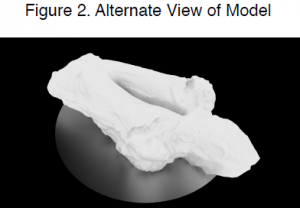Nelson Warner and Dr. Scott Thomson, Mechanical Engineering
Introduction
Although extensive research has been performed to document whale songs, we have little understanding of how baleen whales produce their sound. This project was to create a physical model of a sei whale larynx (voice box) to study the source of vocal production in baleen whales.
Methodology
Whales are the loudest animals in the world. Blue whales have been recorded at creating sounds of 188 dB (Cummings & Thompson, 1971), and yet we know little about something as basic as their production of sound. However, recently an organ found within baleen whales has been identified as a vocal fold (Reidenberg & Laitma, 2007). To begin to investigate whether this vocal fold could be used in whale vocalization, Dr. Scott Thomson, the faculty advisor for this research with expertise in human voice production, traveled to New York to meet with Dr. Joy S. Reidenberg, an expert in whale anatomy and the author of the aforementioned paper. Dr. Reidenberg possessed several dissected and preserved whale larynges and vocal folds, and Dr. Thomson acquired detailed, multi-view images of them that could be used to build anatomically accurate 3D models.
Using the above-mentioned images, acquired by Dr. Thomson, of whale vocal folds, a geometrically-accurate 3D computer model of the vocal folds was created. This was done using the software Autodesk 123D Catch. This put the images together into rough 3D models. These models were then imported into a 3D modeling software called Blender, and modified. They were modified to remove noticed inaccuracies and then merged into several combination models. These were looked at for accuracy, and corrected as needed. These models were then cleaned using another 3D modeling software called Meshlab. This was then taken as a base and used to create a physical model with on-campus rapid prototyping facilities.
Results
While the testing phase was not reached in this project, numerous computer models were created. The images were taken of abducted and adducted folds (open and closed vocal folds). Each of these sets include various combinations of the models produced from their images, symmetrical and asymmetrical versions, and models with varying ranges of texture. These models were modified to balance out distortions from gravity pulling the vocal folds. Images of one of these models are included below (see figure 1 and 2).
A technical note was created using the experience gained through production to describe how future research could reproduce natural geometries accurately and quickly. This will greatly reduce the time required in the future.
Discussion/Conclusion
Dr. Thomson advised this project for two semesters, but has since left for another college. This has resulted in the project being stopped before the testing phase. However if the project continued the model should provide an accurate basis for testing. The images were taken from a sei whale’s larynx. A sei whale is the third largest baleen whale and will provide a reasonable base to initially extrapolate future findings to all baleen whales.
Learning how to apply the software to a previously never used application took much longer than expected. There were many inaccuracies and software issues that had to be addressed. While this delayed the projected timeline of the project, the finished product does represent accurately the geometry shown by the arrays of pictures. Further research should include quantifying the differences between the physical created model and the actual larynx. It should also include a comparison of the varied computer models that were produced.
While the project did not produce any data regarding the source of whale’s songs, the model was completed. This model was sent to Dr. Reidenberg in New York and will help provide a basis for testing hypotheses regarding the bioaccoustics of whales.
Sources
- Cummings W.C., Thompson P.O., (1971). “Underwater Sounds from the Blue Whale, Balaenoptera musculus,” J. Acoustic Society of America. Volume 50(4):, Issue; 4B, pp., 1193-1198.
- Reidenberg J.S., Laitma J.T., (2007). “Discovery of a Low Frequency Sound Source in Mysticeti (Baleen Whales): Anatomical Establishment of a Vocal Fold Homolog,” The Anatomical Record, 290:745-759.


